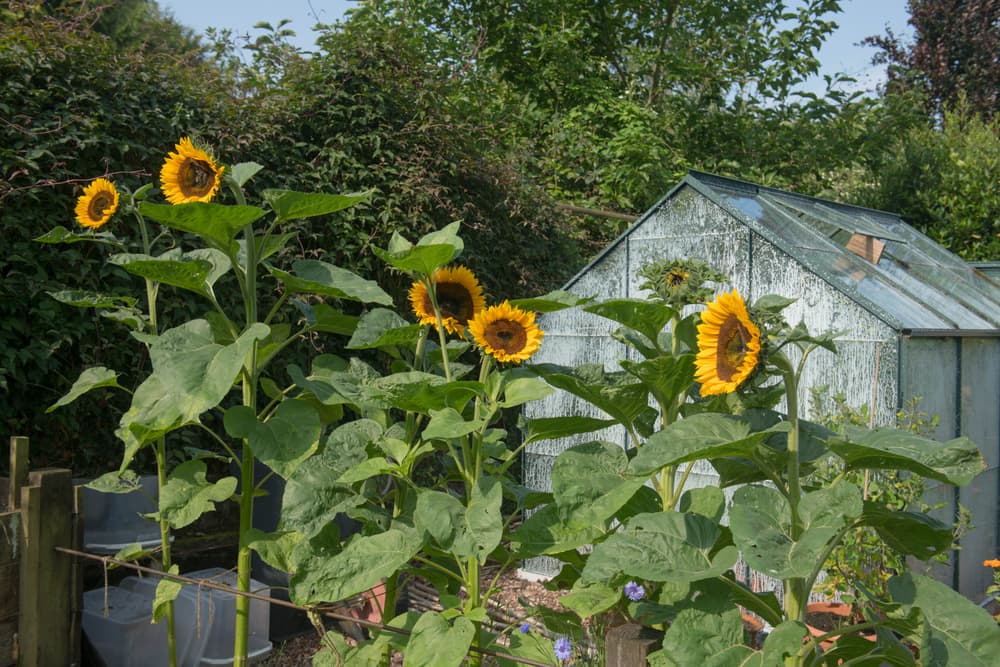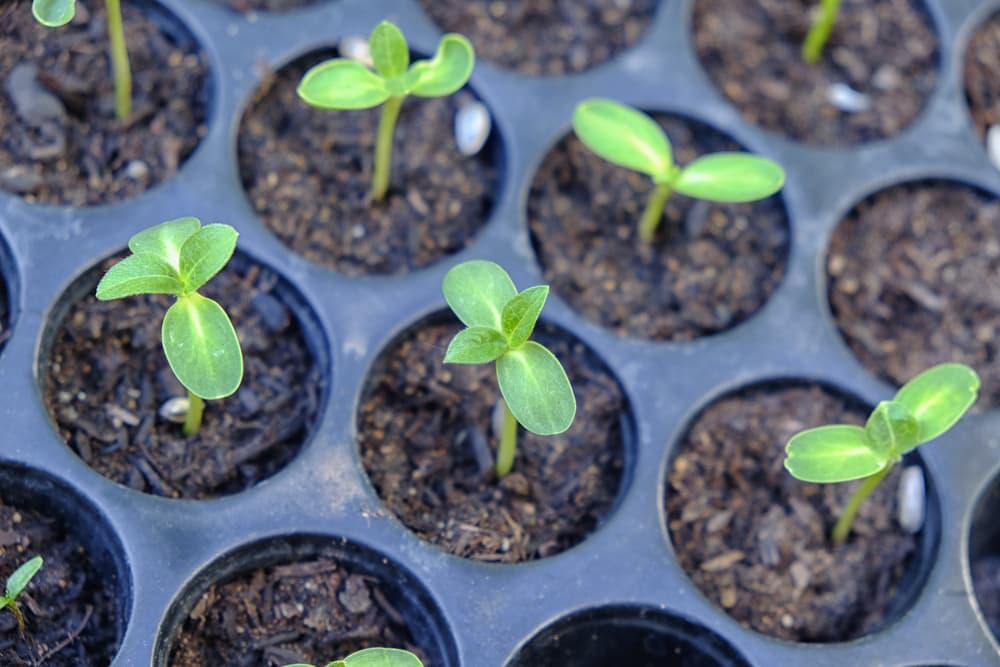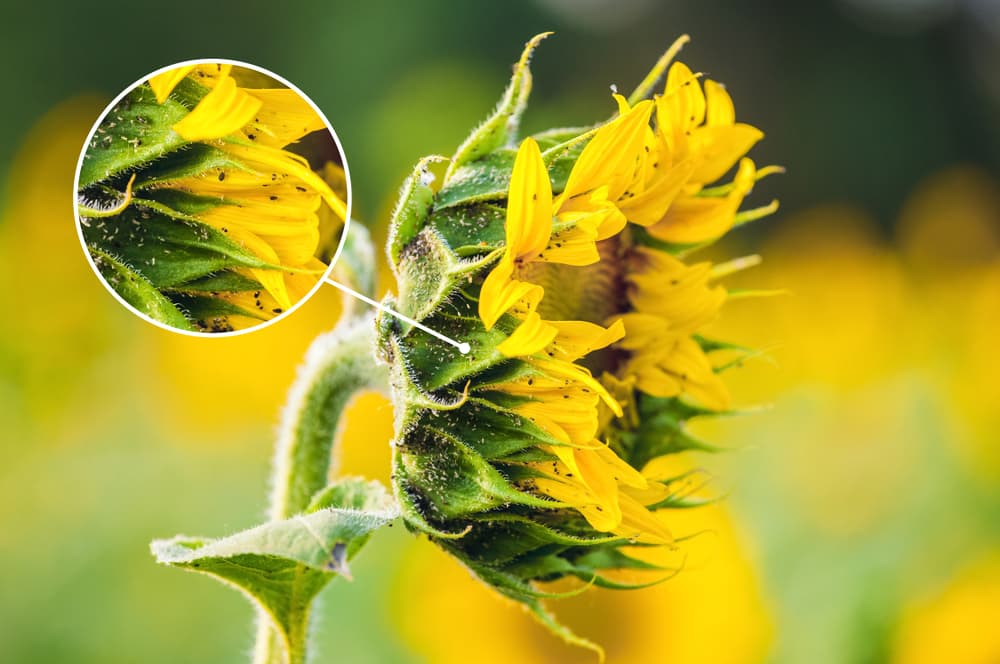ANNUALS > SUNFLOWER

Elizabeth is a Permaculture Garden Designer, Sustainability Consultant and Professional Writer, working as an advocate for positive change. She graduated from the University of St. Andrews with an MA in English and Philosophy and obtained a Diploma in Applied Permaculture Design from the Permaculture Association.
Reviewed By COLIN SKELLY

Colin is a Horticulturist and Horticultural Consultant with experience in a range of practical and managerial roles across heritage, commercial and public horticulture. He holds the Royal Horticultural Society’s Master of Horticulture award and has a particular interest in horticultural ecology and naturalistic planting for habitat and climate resilience.
IN THIS GUIDE
SUNFLOWER GUIDES
Container Growing
Deadheading
Drooping
Harvesting
Sowing
Support
Varieties
Sunflowers are great for novices and experienced gardeners alike, and can find a place in many gardens.
Kids will love learning to grow them with you, and as an easy plant to grow, they can be your gateway to growing your own – no matter how green-fingered you may be.
You might think you know these familiar flowers well, but they can be surprising.
Overview
| Botanical Name | Helianthus annuus |
| Common Name(s) | Sunflower |
| Plant Type | Annual Flower |
| Native Area | Americas |
| Hardiness Rating | H4 |
| Foliage | Broad, oval to heart-shaped, rough hairy leaves |
| Flowers | Huge flowers up to 30cm across with bright yellow petals |
| When To Sow | April, May |
| Flowering Months | June, July, August |
Sunlight
Preferred Sunlight
Full Sun
Exposure
Sheltered
Size
Height
2.5 – 4M
Spread
0.5 – 1M
Bloom Time
June – August
Soil
Preferred Soil Type
Most Soil Types
Moisture
Moist but well drained
pH
Neutral / Alkaline
The common sunflower, Helianthus annuus, is a tall and fast-growing annual.
In summer, of course, the plant bears huge flowers up to 30cm across, with bright yellow petals and large brownish centres.
Heliotropism
One fascinating thing about sunflowers is that they offer an example of a natural phenomenon known as ‘Heliotropism’.
While the flower heads are young, the flowers generally tend to turn to follow the sun across the sky as it travels from east to west.
Researchers have come to the conclusion that sunflowers show this specific type of heliotropism because their stems elongate at different rates on each side at different times of the day.1Briggs, W. (2016, August). How do sunflowers follow the Sun – And to what end? Research Gate. Retrieved March 24, 2023, from https://www.researchgate.net/publication/305890471_How_do_sunflowers_follow_the_Sun_-_And_to_what_end

This ‘solar tracking’ can be a fascinating natural phenomenon to witness when growing sunflowers in your own garden.
It is thought that facing the sun during the day in the early stages of growth brings benefits for these plants.
Not only does it maximise photosynthesis, it also increases warming of the flower on each plant, thereby attracting more insects for pollination.
Researchers at the University of Virginia found that east-facing mature sunflower blooms drew five times the number of pollinating insects when compared to west-facing ones.2Sunflowers move from east to west, and back, by the clock. (n.d.). National Science Foundation. Retrieved March 24, 2023, from https://www.nsf.gov/news/news_summ.jsp?cntn_id=139271
Why Grow Sunflowers?
Sunflowers are great plants to grow for a great many reasons.
Easy To Grow
For one thing, they are a fantastic choice because they are very easy to grow.

The seeds are large and easy to handle, and the plants germinate and grow quickly so you do not have to wait around too long to see impressive results.
Visual Appeal
Sunflowers look beautiful and very impressive, with their enormous heads; planting just a few can have a big impact on the visual appeal in a garden.
Another thing to consider is that the structure of the sunflowers, which grow heads and shoulders above many other flowering plants, means they can add height and structure to a bed or border.
Companion Benefits
Sunflowers are great mixed in with other flowering plants in an ornamental border, but they can also work well as companion plants in a kitchen garden.
Not only do these flowers attract plenty of pollinators to your garden while they are in bloom, they also attract predatory insects like lacewings and parasitic wasps that help keep pest numbers down.

They can also serve as structure for climbing edibles like beans to grow up.
Edible Yields
It is also worth noting that they are an edible plant in their own right.
They not only produce edible seeds towards the end of the season – the petals are edible too.
One thing to note, however, is that sunflowers are known to be allelopathic – in other words, they can suppress the growth of certain other plants when grown close by.3Leather, G. R. (1983). Sunflowers (Helianthus annuus) are Allelopathic to Weeds. Weed Science, 31(1), 37–42. https://doi.org/10.1017/s004317450006851x
You should avoid planting sunflowers too close to potatoes, for example.
How To Grow Sunflowers
As mentioned above, sunflowers could be grown in an ornamental bed or border, or in a vegetable garden.
They will do best, as their name suggests, in an area that receives full sun.
Though they can also potentially cope with partial shade, they do best where they receive at least 6-8 hours of direct sunlight per day.

When choosing a location for growing sunflowers, it is important to understand that they have long tap roots (to anchor them well as they grow so tall).
Soil Requirements
They need to be planted in an area where the soil is deep enough to accommodate the root system – and they will do best where that soil is loose, moist and well-draining.
Avoid areas with compacted soil, and areas with soils that are outside of the 6.0-7.5 pH range.
The soil should be fertile and nutrient-rich, and it is a good idea to top-dress the area with plenty of organic matter before planting.
Sowing
In order to avoid pest issues, it is generally best to sow seeds indoors before transplanting seedlings later to their final growing positions.
Seeds should be sown in small pots, modules or soil blocks indoors before the last frost, or, if you do prefer to sow directly, this should be done after you are certain that the last frost of the winter has passed.

Ideally, you should wait until the soil has warmed to between 13-16°C.
- Choose a fertile and balanced, moist yet free-draining growing medium for sowing your seeds.
- Sow each seed by making a hole in the growing medium and placing a seed in each one, at a depth of around 2cm.
- Gently firm the soil back over the seed and water it in.
- Then leave it in a sunny spot for germination to take place.
- If you wish, you can improve your chances of success by sowing 2-3 seeds in each pot, and then removing the weaker seedlings once they emerge to leave one seedling per pot.
One fun (and educational) game for kids is to have each child plant a sunflower, then have a ‘race’ to see whose grows the tallest the fastest.
Each child should take care of their own seedling, watering it as required and trying different methods to affect their growth.
Sunflower Plant Care
Sunflowers do not require much care.
They do not need much fertiliser and, in fact, will not thrive if you fertilise them too much.

Coddled plants will tend to have weaker stems, that can break towards the end of the summer or in autumn.
“The biggest problem with growing sunflowers that I come across is weak, elongated stems that snap when they are planted out,” shares Horticulturist and Consultant Colin Skelly.
“Once the seedlings have true leaves, put them out into a cold frame or place them outside for a time during the day. This will allow the seedlings to grow ‘hard’ and produce stouter, stronger stems for planting out.”
Watering
When the seedlings are still small, especially if they are growing in a heated indoor space, you will have to regularly water to make sure that the growing medium around the root zone of your plants does not dry out.
However, once the plants are more established, and certainly after you have hardened them off and transplanted them to their final growing positions, you should water far less frequently.

Watering well on a less frequent basis rather than watering little and often is the best policy.
It will encourage the plants to root deeply, which will make them stronger as the season progresses.
Common Problems
Slugs & Snails
The biggest problems for sunflowers are often slugs and snails – they love sunflowers and can quickly destroy a young plant.
Try to take natural measures to reduce slug and snail populations in your garden – such as attracting plenty of birds, amphibians and mammals that eat them.
Choosing the right plants and creating different habitats (garden ponds and wild native hedgerows for example) should help.
You can also place collars or barriers of material around young sunflower plants, and/or place slug traps nearby.
Aphids
Another thing you might notice about sunflowers is that ants may herd aphids onto them.

One of the strange phenomena that occur in a garden is ants ‘farming’ aphids.
But if ants herd aphids onto sunflowers, it is worthwhile remembering that this means they are keeping them away from your fruits and vegetables.
This means sunflowers could also serve as useful companion plants in a kitchen garden because they can serve as a trap crop.
Harvesting Sunflowers
You can harvest sunflowers while they are in full bloom and use them for displays of cut flowers inside your home.
Ideally, cut the stems early in the morning so they will last longer; you can also dry them for longer-lasting displays.
If you want the seeds, leave the sunflowers in place into autumn for these to form, and, if you want to stop birds from eating them all, keep a close eye on the heads, so you can get to them before they are gone.
You can obviously eat some seeds, but why not also save some to sow in your garden next year?
References
- 1Briggs, W. (2016, August). How do sunflowers follow the Sun – And to what end? Research Gate. Retrieved March 24, 2023, from https://www.researchgate.net/publication/305890471_How_do_sunflowers_follow_the_Sun_-_And_to_what_end
- 2Sunflowers move from east to west, and back, by the clock. (n.d.). National Science Foundation. Retrieved March 24, 2023, from https://www.nsf.gov/news/news_summ.jsp?cntn_id=139271
- 3Leather, G. R. (1983). Sunflowers (Helianthus annuus) are Allelopathic to Weeds. Weed Science, 31(1), 37–42. https://doi.org/10.1017/s004317450006851x

